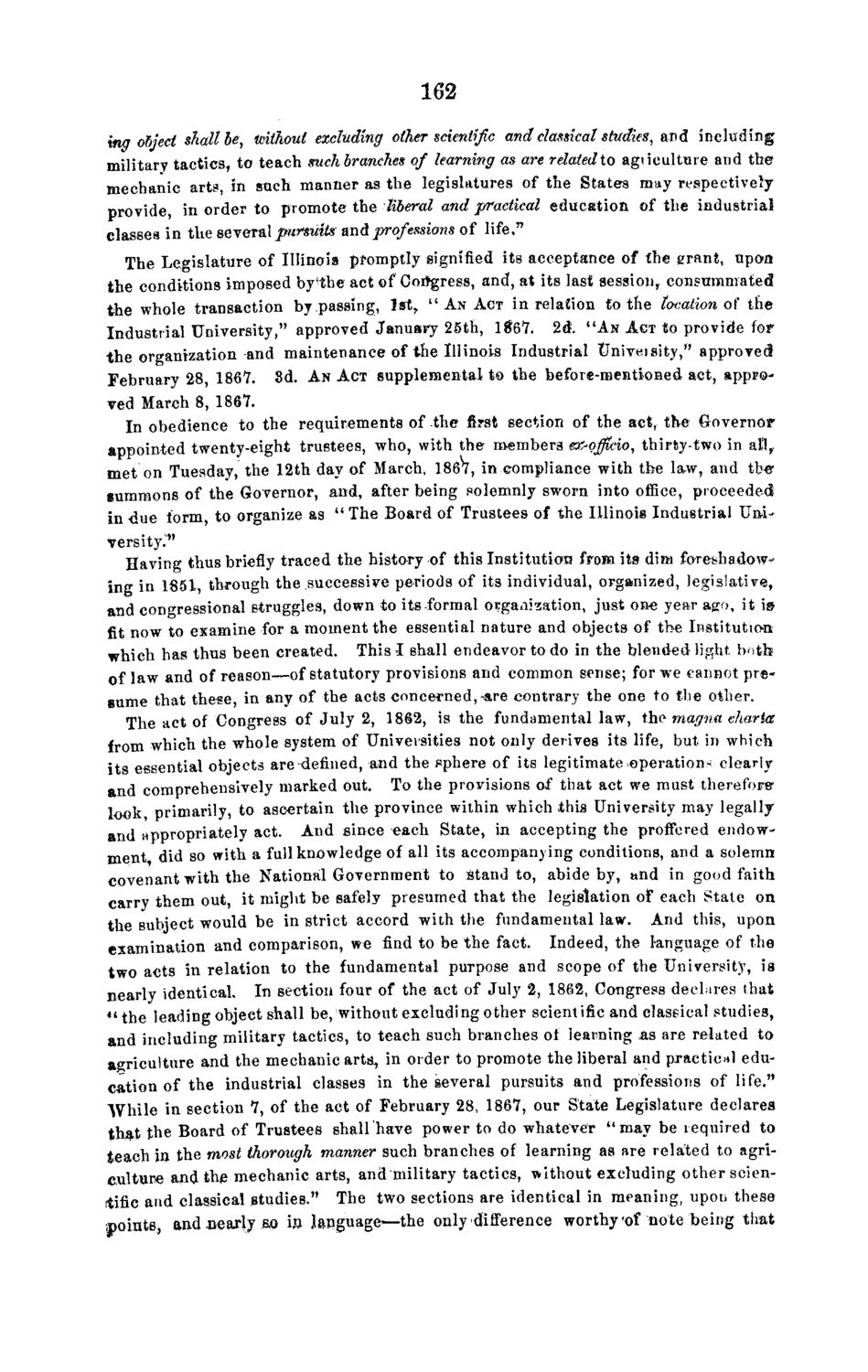| |
| |
Caption: Board of Trustees Minutes - 1868
This is a reduced-resolution page image for fast online browsing.

EXTRACTED TEXT FROM PAGE:
162 ing object shall be, without excluding other scientific and classical studies, and including military tactics, to teach such branches of learning as are related to agriculture and the mechanic arts, in such manner as the legislatures of the States may respectively provide in order to promote the liberal and practical education of the industrial classes in the several pursuits mdprofessions of life," The Legislature of Illinois promptly signified its acceptance of the grant, upon the conditions imposed by*the act of Congress, and, at its last session, consummated the whole transaction bypassing, 1st, " AN ACT in relation to the location of the Industrial University," approved January 25th, 1^67. 2d " A N ACT to provide for the organization and maintenance of the Illinois Industrial TJniveisity," approved February 28, 1867. 8d. AN ACT supplemental to the before-mentioned act, approved March 8, 1867. In obedience to the requirements of the first section of the act, the Governor appointed twenty-eight trustees, who, with the members e&officio, thirty-two in all, met on Tuesday, the 12th day of March, 1867, in compliance with the law, and the summons of the Governor, and, after being solemnly sworn into office, proceeded indue form, to organize as "The Board of Trustees of the Illinois Industrial University." Having thus briefly traced the history of this Institution from its dim foreshadowing in 1851, through the successive periods of its individual, organized, legislative, and congressional struggles, down to its formal organization, just one year ago, it i& fit now to examine for a moment the essential nature and objects of the Institution which has thus been created. This I shall endeavor to do in the blended light both of law and of reason—of statutory provisions and common sense; for we cannot presume that these, in any of the acts concerned,-are contrary the one to the other. The act of Congress of July 2, 1862, is the fundamental law, the magna charia from which the whole system of Universities not only derives its life, but in which its essential objects are defined, and the sphere of its legitimate operation- clearly and comprehensively marked out. To the provisions of that act we must therefore" look, primarily, to ascertain the province within which this University may legally and appropriately act. And since each State, in accepting the proffered endowment did so with a full knowledge of all its accompanying conditions, and a solemn covenant with the National Government to stand to, abide by, and in good faith carry them out, it might be safely presumed that the legislation of each Stale on the subject would be in strict accord with the fundamental law. And this, upon examination and comparison, we find to be the fact. Indeed, the language of the two acts in relation to the fundamental purpose and scope of the University, is nearly identical. In section four of the act of July 2, 1862, Congress declares that " the leading object shall be, without excluding other scientific and classical studies, and including military tactics, to teach such branches of learning its are related to agriculture and the mechanic arts, in order to promote the liberal and practical education of the industrial classes in the several pursuits and professions of life." While in section 7, of the act of February 28, 1867, our State Legislature declares that the Board of Trustees shallhave power to do whatever "may be required to teach in the most thorough manner such branches of learning as are related to agriculture and the mechanic arts, and military tactics, without excluding other scientific and classical studies." The two sections are identical in meaning, upon these points, and nearly & i» language—the only difference worthy of note being that o
| |